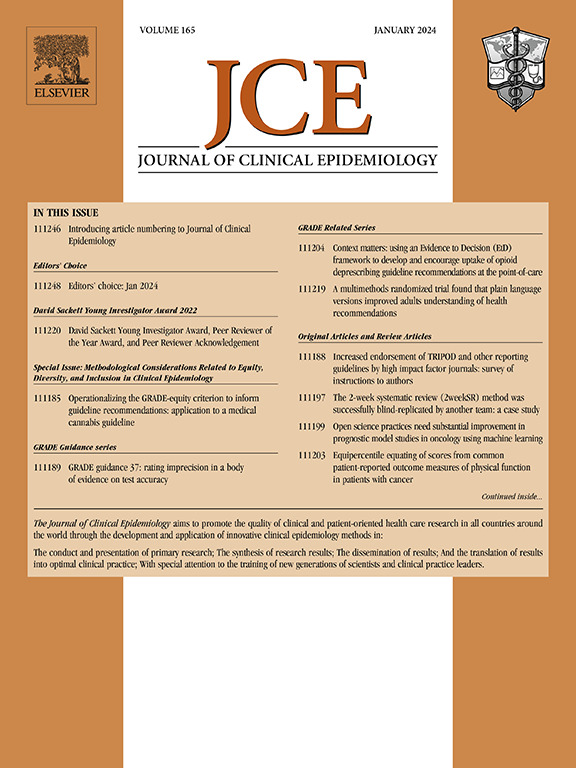Quantitative assessment of inconsistency in meta-analysis using decision thresholds with two new indices
IF 7.3
2区 医学
Q1 HEALTH CARE SCIENCES & SERVICES
引用次数: 0
Abstract
Objectives
In evidence synthesis, inconsistency is typically assessed visually and with the I2 and the Q statistics. However, these measures have important limitations (i) if there are few primary studies of small sample sizes or (ii) if there are multiple studies with precise estimates. In addition, with the increasing use of decision thresholds (DT), for example in Grading of Recommendations Assessment, Development and Evaluation evidence to decision (EtD) frameworks, inconsistency judgments can be anchored around DTs. In this article, we developed quantitative measures to assess inconsistency based on DTs.
Study Design and Setting
We developed two measures to quantify inconsistency based on DTs – the decision inconsistency (DI) and the across-studies inconsistency (ASI) indices. The DI and the ASI are based on the distribution of the posterior samples studies’ effect sizes (ES) across interpretation categories defined by DTs. We developed these indices for the Bayesian context, followed by a frequentist extension.
Results
The DI informs on the overall inconsistency of ESs across interpretation categories, while the ASI quantifies how different studies are compared to each other (in relation to interpretation categories) based on absolute effects. A DI ≥ 50% and an ASI ≥ 25% are suggestive of important inconsistency. We provide an R package (metainc) and a web tool (https://metainc.med.up.pt/) to support the computation of the DI and ASI, including in the context of sensitivity analyses assessing the impact of potential uncertainty in inconsistency.
Conclusion
The DI and the ASI can contribute to quantitatively assess inconsistency, particularly as DTs are gaining recognition in evidence synthesis and health decision-making.
用两个新指标的决策阈值定量评估meta分析的不一致性。
目的:在证据合成中,通常用I2和Q统计来评估不一致性。然而,这些措施有重要的局限性(i)如果很少有小样本量的初步研究,或(ii)如果有多个具有精确估计的研究。此外,随着越来越多地使用决策阈值(DT),例如在将证据分级到决策框架中,不一致性判断可以围绕DT进行锚定。在本文中,我们开发了定量的方法来评估基于dt的不一致性。研究设计和设置:我们开发了两种测量方法来量化基于DTs的不一致性-决策不一致性(DI)和跨研究不一致性(ASI)指数。DI和ASI是基于后验样本研究的效应大小在由dt定义的解释类别中的分布。我们为贝叶斯上下文开发了这些指标,然后进行了频率扩展。结果:DI报告了不同解释类别效应大小的总体不一致性,而ASI量化了基于绝对效应的不同研究(相对于解释类别)如何相互比较。DI≥50%和ASI≥25%提示存在重要的原因不明的不一致。我们提供了一个R包(mec)和一个web工具(https://metainc.med.up.pt/)来支持DI和ASI的计算,包括在敏感性分析的背景下评估不一致的潜在不确定性的影响。结论:DI和ASI有助于定量评估不一致性,特别是当DTs在证据合成和卫生决策中得到认可时。
本文章由计算机程序翻译,如有差异,请以英文原文为准。
求助全文
约1分钟内获得全文
求助全文
来源期刊

Journal of Clinical Epidemiology
医学-公共卫生、环境卫生与职业卫生
CiteScore
12.00
自引率
6.90%
发文量
320
审稿时长
44 days
期刊介绍:
The Journal of Clinical Epidemiology strives to enhance the quality of clinical and patient-oriented healthcare research by advancing and applying innovative methods in conducting, presenting, synthesizing, disseminating, and translating research results into optimal clinical practice. Special emphasis is placed on training new generations of scientists and clinical practice leaders.
 求助内容:
求助内容: 应助结果提醒方式:
应助结果提醒方式:


